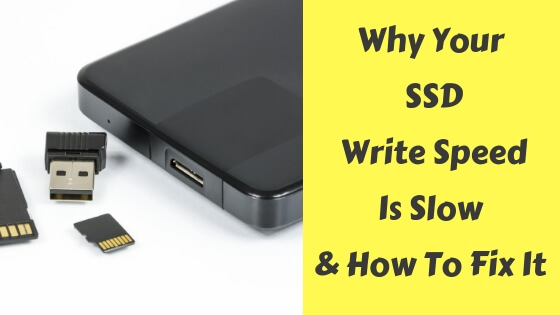This is not what you’ve expected, right? You see, read and hear all this hype about how much SSDs are faster compared to HDDs but once you get one you start to notice a weird problem, the write speed is slow, why that! Well, let’s calm down for a bit before we make any false assumptions.
SSDs are truly faster than their counterparts but there are some cases where it slows down to a very low speed, solid state drives or SSD is more expensive and more future proof and has a lot of features over hard disk drives or HDD, because you paid a lot for it you should expect some quality and speed, right? Okay, let’s get started and see why that happens and how you can fix it or at least improve its performance a little bit.
Just so you know, SSDs have a read speed of 540 MB/s and write speed of 520 MB/s. It should vary though from one user to another and based on different conditions.
The Amount of Free space left
The first common reason for this behavior is that the nature of solid state drives tend to make it slower as it fill up, SSD needs to have some space for some calculations in order to maintain a really high speed.
Some people recommend that you should leave around 15% of free space and others say you shouldn’t exceed 70% of total space.
So if you really need to have more space then you should upgrade the one you have or get an external one alongside it, if you can’t afford an SSD type then go for an HDD, that way you’ll have more storage for the price, I know what you’re thinking (but I don’t want an HDD), if you’re looking for speed then I’d say you should store your operating system along with other important programs and games on the SSD storage and leave other files like movies, music… etc on the HDD storage, sounds fair?
Intel Rapid Storage Driver
In a nutshell, Intel Rapid Storage is a technology that was released by Intel in order to increase the performance of storage drives like SSD and improving the response time.
It also has a built-in feature to use both HDD and SSD (if you have both) to work even better especially if you had small capacity SSD.
If your system has an Intel chipset and supports this technology then I highly recommend you download it immediately and give it a try, here’s the link to this technology
More is Better
People suggest that you get a larger drive if you don’t already have one, larger drivers are faster than ones with 120GB or so.
Remember the first point where I told you that your SSD will slow down as it fills up? Getting a larger drive is recommended in this case.
Replace It
If it’s a new drive and you’ve tried everything to find what’s wrong with it and came up with nothing then you should pay a visit to the store and let them have a look at it or simply tell them to replace it or get a refund.
You shouldn’t go for other unknown brands in order to get a cheaper SSD, quality parts, especially in the tech space, are expensive you know.
Tip 1: Make sure AHCI is set and TRIM is enabled (a quick search should teach you how to do it)
Tip 2: Update the SSD’s firmware and perform a secure erase, copy all the important files to an external HDD before doing this.
Tip 3: Use software like Driver Booster to update all your drivers and see if it helps.
Warning: If you ever wanted to check your SSD performance then you should never run endurance tests because it’ll wear your SSD out, you should instead use software like CrystalDiskMark
